Cosimo de' Medici
![]()
The title of this article is ambiguous. For other meanings, see Cosimo de' Medici (disambiguation).
Cosimo de' Medici (called il Vecchio 'the Old'; * 10 April 1389 in Florence; † 1 August 1464 in Careggi near Florence) was a statesman, banker and patron of the arts, who for decades guided the politics of his native Florence and made a significant contribution to its cultural revival. Because of his affiliation to the Medici family (German also "Mediceer") he is called "de' Medici"; it is not a noble predicate, the family was bourgeois.
As heir to the rapidly expanding Medici bank founded by his father Giovanni di Bicci de' Medici, Cosimo was innately part of the city's ruling class. His business success made him the richest citizen of Florence. The framework for his political activity was provided by the city's republican constitution, which he respected in principle but transformed with the help of his large following. In doing so, he prevailed against fierce opposition from some families who had previously set the tone. His decisive influence on politics was not based on the offices to which he was elected, but on the skilful use of his financial resources and an extensive network of personal connections at home and abroad. He succeeded in forging a lasting alliance with Milan, a previously hostile city, thus creating foreign policy stability that lasted after his death.
Cosimo's political successes, his extensive support for the arts and education, and his imposing building activities gave him a unique authority. Nevertheless, he could not make decisions on sensitive issues on his own authority, but always remained dependent on consensus-building among the ruling class. He took care not to appear like a ruler, but like a citizen among citizens.
The extraordinary prestige Cosimo enjoyed was reflected in the posthumous award of the title Pater patriae ("Father of the Fatherland"). With his fortune, the informal position of power he had attained passed to his descendants, who continued his patronage on a grand scale. Until 1494 the Medici played a dominant role in Florentine politics and cultural life.
In modern research, Cosimo's achievements are predominantly judged positively. His statesmanlike moderation and foresight, his entrepreneurial competence and his cultural commitment receive much recognition. On the other hand, attention is also drawn to the great potential for conflict that resulted from the massive, enduring dominance of an overpowering family in a republican, traditionally anti-autocratic state. In the longer term, Cosimo's concept of indirect state control by means of a private fortune proved unsustainable; in the last decade of the 15th century, the system he had established collapsed.
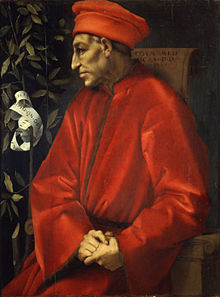
Cosimo de' Medici. Posthumous painting by Jacopo da Pontormo, c. 1519/1520. Florence, Uffizi Gallery
The political conditions
After the collapse of the Hohenstaufen Empire in the 13th century, a power vacuum had arisen in northern and central Italy, the so-called Imperial Italy, which no one was able to fill. Although the Roman-German kings continued to make Italian campaigns in the 14th and 15th centuries (such as Henry VII, Louis IV and Frederick III), they did not succeed in permanently asserting imperial power in imperial Italy. The traditional tendency to fragment the political landscape generally prevailed in the late Middle Ages. A multitude of local and regional centres of power emerged, which continually fought each other in changing constellations. Chief among these were the great cities, which accepted no superior power and strove to form larger territories under their control. North of the Papal States, the main players were autocratically ruled Milan, the bourgeois republic of Florence, and the noble republic of Venice, which was not part of Imperial Italy. Politics was primarily shaped by the sharp antagonisms between neighboring cities. There was often hereditary enmity between them; the larger sought to hold down or completely subjugate the smaller, and met with bitter resistance. The costs of the military conflicts, which flared up again and again, often led to a serious economic weakening of the municipalities involved, but this did little to dampen the desire for war. Moreover, fierce power struggles were waged in the cities between individual clans and political factions, usually resulting in the execution or banishment of the leaders and notable partisans of the losing side. One of the main goals of most political actors was to maintain and increase the power and prestige of their own family.
Some municipalities were ruled by autocrats who had established or inherited tyranny. This form of government, branded by republicans as tyranny, is referred to in the literature as signorie (not to be confused with signoria as the name for a city council). It was usually associated with dynasty formation. Other city-states had a republican constitution that allowed a relatively broad ruling class to share power directly.
In Florence, the home of the Medici, there was traditionally a republican state order that was firmly anchored and supported by a broad consensus. The bourgeoisie, organized in guilds and trade guilds, predominantly engaged in commercial or industrial activities, ruled. An elaborate system of separation of powers had been devised to prevent a dangerous concentration of power. The most important organ of government was the nine-member Signoria, a council whose members were elected six times a year. The brevity of the two-month term was intended to discourage tyrannical aspirations. The city, which had a population of about 40,000 in 1427, was divided into four districts, each of which provided two priori (members of the Signoria). To the eight priori was added the ninth member, the gonfaloniere di giustizia (standard bearer of justice). He was the chairman of the body and therefore enjoyed the highest prestige among all municipal officials, but had no more power than his colleagues. The government included two other bodies: the council of the dodici buonomini, the "twelve good men," and the sixteen gonfalonieri (standard-bearers), four for each district. These two bodies, in which the middle classes were strongly represented, took positions on political issues and could block bills. Together with the Signoria, they formed the group of tre maggiori, the three leading institutions that directed the state. The tre maggiori proposed new laws, but they could not be enacted until they had been approved by a two-thirds majority of two larger bodies, the three-hundred-member popular council (consiglio del popolo) and the two-hundred-member municipal council (consiglio del comune). In these two councils, the term of office was four months.
There were also commissions responsible for specific tasks under the authority of the Signoria. The most important of these were the eight-member security committee (otto di guardia), which was responsible for internal state security and directed intelligence activities, and the dieci di balìa ("ten plenipotentiaries"), a body with a six-month term of office that dealt with foreign and security policy and planned and supervised military action in the event of war. The dieci di balìa largely held the strings of diplomacy. Therefore, when the Medici took over the governance of the state, they became a central instrument in directing foreign policy.
The deep mistrust of overpowering individuals and groups that prevailed in Florence was the reason why most officeholders, especially the members of the tre maggiori, were neither elected by majority vote nor appointed on the basis of a qualification. Rather, they were chosen by lot from among all the citizens recognized as fit to hold office-about two thousand persons. The slips of paper with the names were placed in lottery bags (borse), from which the slips of paper of the future office holders were then drawn blindly. For the Signoria there was a prohibition of successive terms of office. One was allowed to hold office only once in three years, and no one from the same family was allowed to have belonged to the body in the previous year.
Eligibility to participate in the draws had to be reviewed at certain intervals - theoretically every five years, in fact somewhat more irregularly. This was the purpose of the squittinio, a procedure by which it was determined who fulfilled the requirements of fitness for office. These included freedom from tax debts and membership in at least one of the guilds. There were "greater" (meaning more prestigious and powerful) and "lesser" guilds, and six of the eight prior seats in the Signoria were reserved for the greater ones. The result of the squittinio in each case was a new list of citizens with full political rights. Those who belonged to one of the larger guilds (arti maggiori) and had been found fit in the squittinio could count themselves among the patriciate of the city. Since the squittinio offered opportunities for manipulation and decided the social rank of the citizens involved in political life, its implementation was politically sensitive.
The system of appointments by lot had the advantage that many members of the city's ruling class were given the opportunity to hold honorable offices and thus satisfy their ambition. Each year, the main bodies of the city administration were filled with 1650 new people. One disadvantage of the frequent change of leadership was its unpredictability; a new signoria could steer a very different course from her predecessor if the majority situation had changed by chance of the casting of lots.
For special crisis situations, the assembly of a parlamento was provided for. This was an assembly of all male citizens over the age of 14, with the exception of the clergy. The parlamento could elect a commission for emergencies, a balìa, and endow it with special powers to deal with the crisis.
Live
Origin, youth and probation in the banking business (1389-1429)
Cosimo was born in Florence on 10 April 1389. His father was Giovanni di Bicci de' Medici (1360-1429), his mother Piccarda de' Bueri. It was customary at that time to give the name of the father for the purpose of distinguishing between persons of the same name; hence Giovanni was called "di Bicci" (son of Bicci) and his son Cosimo "di Giovanni". Cosimo had a twin brother named Damiano, who died soon after birth. The brothers were given their names after Cosmas and Damian, two ancient martyrs who were also twins and venerated as saints. This is why Cosimo later celebrated his birthday not on April 10, but on September 27, which was then the feast day of the holy brother and sister.
Cosimo's father was of bourgeois origin. He belonged to the widespread Medici clan. Medici were already engaged in banking in Florence in the late 13th century, but by the 1360s and 1370s the clan was for the most part not yet wealthy; indeed, most of their households were relatively poor. Nevertheless, the Medici already played an important role in politics; in the 14th century they were frequently represented in the Signoria. In their struggle for prestige and influence, however, they suffered a serious setback when their spokesman Salvestro de' Medici was clumsily tactical in the Ciompi revolt of 1378: he initially sided with the insurgents but later changed his stance. This earned him a reputation for fickleness. He was suspected of striving for tyrannical rule, and eventually had to go into exile in 1382. Subsequently, the Medici were considered unreliable. By 1400 they were so discredited that they were forbidden to hold public office. However, two branches of the clan were exempt from the ban; Cosimo's father and grandfather belonged to one of them. The experience of 1378-1382 was a drastic one for the Medici, urging caution.
Around 1380 Giovanni operated as a small moneylender. This trade was despised at the time; unlike the big banking business, it was suspect to the public, since the moneylenders blatantly flouted the ecclesiastical ban on interest, while the bankers were better able to conceal the interest on their loans. Later Giovanni entered the service of the banker Vieri di Cambio, then the richest member of the Medici clan. From 1385 he headed the Roman branch of Vieri's bank. After the dissolution of Vieri's bank in 1391/1392, Giovanni went into business for himself and took over the Roman branch. With this step he founded the Medici Bank.
Although Rome was by far the most attractive location in all of Italy, Giovanni moved the headquarters of his company to Florence in 1397. The decisive factor here was his desire to return to his hometown. There he single-mindedly created a network of connections, some of which were primarily advantageous from a business point of view, while others served primarily to increase his prestige and political influence. His two sons, Cosimo and Lorenzo, six years younger, received their education in their father's bank and then became involved in shaping its business policy. Among the alliances Giovanni di Bicci made was his association with the traditional noble family of the Bardi. The Bardi had been among the most important bankers in Europe in the first half of the 14th century. Although their bank had collapsed spectacularly in 1345, they were later again successful in the financial sector. Around 1413/1415 the alliance of the two families was reaffirmed by marriage: Cosimo entered into marriage with Contessina de' Bardi di Vernio. Such marriages were an essential part of political and business networking. They had weighty repercussions for a family's social status and influence and were therefore considered carefully. Inheritance created loyalties. However, only part of the Bardi clan was involved in the alliance; some of its branches were among the Medici's opponents.
The first decades of the 15th century were a period of determined expansion for the Medici Bank. It had branches in Rome, Venice and Geneva, and for a time also in Naples. In the period from 1397 to 1420 it made a net profit of 151,820 florins (fiorini). Of this, 113,865 florins remained for the Medici after deducting the share due to a partner. More than half of the profits came from Rome, where the most important business was transacted, and only one-sixth from Florence. Giovanni achieved his greatest success in 1413, when the antipope John XXIII, who resided in Rome and with whom he was on friendly terms, made him his chief banker. At the same time, his branch manager in Rome became papal depositary general (depositario generale), meaning that he took over the administration of most of the church's revenues in exchange for a commission. When John XXIII went to Constance in the autumn of 1414 to attend the council summoned there, Cosimo was reportedly among his entourage. But the following year the Medici suffered a severe setback when the council deposed John XXIII. The Medici bank thus lost its near-monopoly in business with the Curia; in the years that followed it had to compete with other banks. It was only able to regain primacy after one of its main competitors, the Spini Bank, went bankrupt in 1420.
When Giovanni di Bicci retired from the management of the bank in 1420, his sons Cosimo and Lorenzo jointly took over the running of the company. In 1429 Giovanni died. After his death, the family fortune was not divided; Cosimo and Lorenzo together assumed the inheritance, with Cosimo as the elder having the decision-making power. The fortune consisted of about 186,000 florins, two-thirds of which had been earned in Rome, but only one-tenth in Florence-even the Venice branch earned more. In addition to the bank, the family owned extensive property in the surrounding area of Florence, especially in the Mugello, the region from which the family originally came. From then on, the two brothers received two-thirds of the bank's profits, with the rest going to their partners.
Giovanni is said to have advised his sons on their deathbed to act discreetly. They were to act with restraint in public in order to arouse as little envy and ill will as possible. Participation in the political process was vital to a banker's existence, otherwise he could expect to be outmaneuvered by enemies and rivals. Because of the fierceness and unpredictability of political disputes in the city, however, too much profiling was very dangerous, as the Ciompi uprising had shown. Conflicts were therefore to be avoided as far as possible.
Power struggle and banishment (1429-1433)
With the economic success and social advancement of the Medici, their claim to political influence grew. Despite their reserved appearance, they met with resistance from some of the traditionally influential clans, who saw themselves pushed back. Thus two large groupings were formed, which lurked opposite each other. On the one side stood the Medici with their allies and the broad clientele of those who profited directly or indirectly from their business, their commissions, and their influence. In the opposing camp were gathered the clans who wished to retain their traditional position of power and put the upstarts in their place. Among them the Albizzi family was the most important; its head Rinaldo degli Albizzi became the spokesman of the Medici opponents. This division of the bourgeoisie reflected not only personal differences between leading politicians, but also different mentalities and basic attitudes. The Albizzi group was the conservative circles whose dominance had been threatened in 1378 by the Ciompi uprising, an uprising of the lower classes (popolo minuto) carried by disadvantaged workers. Since that shocking experience, they sought to secure their status by inhibiting the penetration of suspect cliques into authoritative bodies. Sedition, subversion, and dictatorial desires were to be nipped in the bud. The Medici's intermittent support for the rebellious workers was not forgotten. But the Albizzi group was not a party with a unified leadership and a common course, but a loose, informal association of a few clans of roughly equal rank. Apart from opposition to potentially dangerous outsiders, the members of this alliance had little in common. Their basic attitude was defensive. The Medici group, on the other hand, was vertically structured. Cosimo was its undisputed leader, making key decisions and making purposeful use of financial resources far superior to those of his opponents. Rising families (gente nuova) were among the Medici's natural allies, but their following was not limited to forces that could benefit from increased social mobility. The Medici group also included respected patrician dynasties who had allowed themselves to be incorporated into their network, in part through affinity. Apparently, the Albizzi had stronger support among the upper classes, while the Medici enjoyed greater sympathy among the middle classes - the artisans and shopkeepers. The fact that a large part of Cosimo's followers belonged to the traditional elite shows, however, that the interpretation of the conflict as a struggle between classes or estates, which was occasionally held in the past, is mistaken.
The hardening of the opposition made an open power struggle seem inevitable, but in view of the prevailing loyalty to the constitutional order, this had to be fought out within the framework of legality. From 1426 the conflict came to a head. The propaganda of both sides aimed at solidifying images of the enemy. For the Medici supporters, Rinaldo degli Albizzi was the arrogant spokesman of oligarchic forces remote from the people, who lived off his father's fame and lacked leadership qualities as a result of his rashness. The Albizzi group portrayed Cosimo as a potential tyrant who used his wealth to undermine the constitution and pave his way to autocracy through bribery and corruption. Circumstantial evidence suggests that there was considerable kernel of truth in the accusations on both sides: Rinaldo's brusqueness offended influential sympathizers such as the Strozzi family, and he even fell out with his brother Luca to such an extent that the latter renounced family loyalty and defected to the other side, an unusual move for the time. The polemic against the Medici, though probably exaggerated, was also based on fact: The Medici group infiltrated the administration, thereby obtaining secret information, did not shy away from falsifying documents, and manipulated the squittinio in their favor.
The introduction of the catasto, a comprehensive inventory of all taxable property and income, in May 1427 was a source of polemic. The inventory formed the basis of the levy of a newly introduced property tax, which was needed to reduce the dramatically increased national debt. This move caused some shifting of the tax burden from the indirectly taxed middle class to the wealthy patricians. The Medici, who were particularly solvent, were better able to cope with the new burden than some of their less wealthy opponents, for whom the catasto was a hard blow. Although Giovanni di Bicci had initially opposed the introduction of the wealth tax and later reluctantly supported it, the Medici managed to portray themselves as supporters of the measure, which was popular among the population. They were thus able to distinguish themselves as patriots who, to their own detriment, advocated the reorganization of the state budget and made a weighty contribution to it themselves.
The conflict was further fuelled by the war against Lucca, which Florence began at the end of 1429. The military clashes ended in April 1433 with a peace treaty, without the attackers having achieved their war aims. The two hostile cliques in Florence had unanimously supported the war, but then used its unfavorable outcome as a weapon in their struggle for power. Rinaldo had participated in the campaign as a war commissioner, so he could be held partly responsible for its failure. For his part, he blamed the committee of ten responsible for coordinating the conduct of the war, on which Medici supporters were strongly represented; the committee had sabotaged his efforts. Cosimo was able to use this opportunity to cast himself in a favorable light: he had lent the state 155,887 florins, an amount that accounted for more than a quarter of the war's special financial needs. This enabled the Medicean to demonstrate his patriotism and his unique importance for the fate of the Republic in a propaganda-like manner. Overall, the course of the war thus strengthened the position of the Medici group in public opinion.
The strategy of the Albizzi group was to accuse their opponents - above all Cosimo himself - of anti-constitutional activities and thus to put them out of action by means of criminal law. The Medici's enemies were given a means of action in the form of a law they pushed through in December 1429, which was intended to prevent protection that was detrimental to the state and to secure internal peace. It was directed against upstarts who gained illicit advantages through their relations with members of the Signoria, and against great men who stirred up disturbances. This legislation thus targeted Cosimo and his socially and politically mobile clientele. From 1431 onwards, the leaders of the Medici group were increasingly threatened with deprivation of civil rights and banishment. To this end, a special commission was to be formed and empowered to take appropriate action. After the end of the war against Lucca, the danger to Cosimo became acute, as he was now no longer needed as a lender to the state. Thereupon, in the spring of 1433, he initiated the transfer of his capital abroad. He had a large part sent to Venice and Rome, and hid some money in monasteries in Florence. In this way he secured the bank's assets against the risk of expropriation, which was to be feared in the event of a conviction for high treason.
The drawing of lots for the posts in the Signoria for the term of September and October 1433 resulted in a two-thirds majority of the Medici opponents. They did not let this opportunity pass them by. Cosimo, who was out of the city, was invited by the Signoria for a consultation. On his arrival at the city palace on September 5, he was immediately arrested. By a majority of six to three the Signoria decided to banish him, and a special commission confirmed the sentence, saying that he was a destroyer of the state and a cause of scandal. Almost all the members of the Medici clan were excluded from the offices of the Republic for ten years. Cosimo was banished to Padua, his brother Lorenzo to Venice; there they were to remain for ten years. If they left their assigned abodes prematurely, they were threatened with a further sentence, which precluded their returning home for ever. The long duration of the ordered absence was to permanently cripple and tear apart the Medici network. Cosimo had to post a bond of 20,000 florins as a guarantee of his future good conduct. He accepted the sentence, stressing his loyalty to the Republic, and went into exile at the beginning of October 1433.
Turnaround and homecoming (1433-1434)
It soon became apparent that the Medici network not only remained intact in Florence, but even functioned efficiently in distant foreign lands. Cosimo's departure and his journey to Padua became a triumphant demonstration of his influence at home and abroad. Already on the way he received a multitude of expressions of sympathy, expressions of loyalty, and offers of assistance from prominent personages and entire cities. In Venice, to whose territory the place of exile Padua then belonged, the support was particularly strong, which was connected with the fact that the Medici bank had maintained a branch there for decades. When Cosimo's brother Lorenzo arrived in Venice, he was received by the Doge Francesco Foscari himself, as well as many nobles. The Republic of Venice clearly took sides with the persecuted and sent an envoy to Florence to try to have the sentence overturned. The latter at least succeeded in having Cosimo permitted to settle in Venice. The Emperor Sigismund, whom the Venetians had informed, expressed his disapproval of the banishment, which he considered a folly on the part of the Florentines. Sigismund had sought, among other things, a settlement of his relations with the Republic of Florence during his campaign in Italy, from which he returned in October 1433, but had been unable to achieve any success in the negotiations.
The turnaround was finally brought about by a new need for money on the part of the Republic of Florence. Since the state's finances were precarious and the Medici bank was no longer available as a lender, a tax increase was on the horizon. This led to such discontent that over the course of the spring and summer of 1434 the mood among the ruling class tilted. Supporters of the Medici and advocates of reconciliation increasingly gained the upper hand. The new mood was reflected in the Signoria elected for the September and October 1434 term, which was partly decidedly Medici-friendly and partly ready for reconciliation. The new gonfaloniere di giustizia was a determined follower of Cosimo. He enforced the revocation of the sentence of banishment on September 20. Now the leaders of the Albizzi group were threatened with the fate they had prepared for their enemies the previous year. To forestall this, they planned a coup d'état for September 26 and assembled armed men. But since the opposing side had mobilized their forces in time, they did not dare to attack, for without the element of surprise it would have meant a civil war with little chance of success. Finally, Pope Eugene IV intervened as a mediator. The Pope had been driven from Rome by a popular uprising and had been living in exile in Florence for some months. As a Venetian, Eugene tended to be Medici-friendly, and more importantly, he could hope for future loans from the Medici bank. He succeeded in persuading Rinaldo to surrender.
On 29 September Cosimo set out for his homecoming, which, like his departure, was triumphant. On 2 October, Rinaldo and some of his companions were banished. The Medici group had thus finally decided the power struggle in their favour. As the victor, Cosimo appeared conciliatory and acted cautiously as usual. However, in order to secure his position, he considered it necessary to send 73 enemy citizens into exile. Many of them were later allowed to return and even qualified for the Signoria again.
The causes of the outcome of the power struggle were analyzed in the early 16th century by Niccolò Machiavelli. He drew general lessons from it, including his famous insistence that a conqueror of power must commit all the inevitable atrocities in one fell swoop immediately after taking possession of the state. Machiavelli's assessment that the Albizzi group was doomed by its indecision and half-heartedness is shared by modern scholars. Other factors that harmed the Medici opponents were their lack of internal cohesion and a leadership that possessed authority. Added to this was their lack of support abroad, where Cosimo had powerful allies.
Activity as a statesman (1434-1464)
After his triumphant return, Cosimo became the de facto leader of the Florentine state and remained in this informal position until his death. Outwardly he respected the institutions of the republican constitution, but he did not aspire to an office with special powers. He acted from the background by means of his wide-ranging domestic and foreign network.
The banking business as a material basis
Cosimo and his contemporaries were always aware of the fact that the basis of his political power was his commercial success. The cohesion of his network depended first and foremost on the flow of money, which could not be allowed to dry up. Banking flourished in northern and central Italy, and no one was more successful at it than he. He was also unsurpassed in his time in the art of using financial resources for political ends. Under his leadership, the Medici Bank continued to expand; new branches were opened in Pisa, Milan, Bruges, London and Avignon, and the Geneva branch was moved to Lyon.
One of the main sources of income for the large banks operating nationwide, especially the Medici Bank, was lending to rulers and ecclesiastical dignitaries. The need for credit was particularly great for the popes, who had enormous revenues from the entire Catholic world, but who repeatedly ran into bottlenecks because of costly military undertakings. Loans to rulers were lucrative but involved considerable risk. One had to reckon with the possibility that such debtors would refuse to repay or, after a loss-making war that they had financed with borrowed capital, would no longer be solvent, at least temporarily. Another risk was the violent death of the debtor through an assassination attempt or on a campaign. Defaults caused by such events could lead to insolvency even for large banks. Assessing the opportunities and risks of such transactions was one of Cosimo's most important tasks.
A banker of the 15th century needed political talent and great diplomatic skill, for business and politics were fused and linked with manifold family interests. Granting loans was often also de facto taking sides in the bitter conflicts between rulers, cities or even parties within a citizenry. Decisions to grant, limit, or deny loans or support money had far-reaching political consequences; they created and preserved alliances and networks or generated dangerous enmities. They also had military effects, for the numerous wars among the northern and central Italian cities were fought with the costly use of mercenary leaders (condottieri). These were only available with their troops as long as the client was solvent; when this was no longer the case, they allowed themselves to be poached by the enemy or plundered on their own account. Some of the decisions Cosimo made as a banker made only political sense, not commercial sense. Some of his payments were politically inevitable but economically pure losing trades. They served to cultivate his prestige or to secure the loyalty of allies. These included rewards for political services rendered and the performance of tasks considered patriotic duties.
In Florence, the Medici Bank's main sources of income were money exchange and the granting of loans to members of the upper classes who had fallen into financial difficulties. Loans were needed in particular for the payment of tax debts, because tax defaulters were not allowed to hold office. Far more important, however, was the loan business with foreign rulers. The bank's most important business partner was the Pope, whose main banker was Cosimo. It was mainly thanks to the connection with the Curia that the bank's Roman business was the most lucrative. The interest earned there and the commissions on the transactions made offered a high profit margin, and the business was very extensive because of the constant need for money on the part of the Curia. Therefore, the Rome branch generated most of the profits. Moreover, the close relationship with the Curia also had a politically advantageous effect. When the pope left Rome, the Roman branch followed him; it was always to be found where his court was.
Apart from political and economic competence, the most important factor on which a banker's success depended was his knowledge of human nature. He had to be able to correctly assess the creditworthiness of his customers and the reliability of his out-of-town branch managers, who had many opportunities for fraud. Cosimo, like his father, possessed these skills to a great degree. His discretion, sobriety, foresight, and skillful dealings with business associates won him respect. Modern research also pays tribute to these qualities of the medicean, which contributed significantly to his commercial and political success.
Cosimo's correspondence with the manager of the Medici Bank branch in Venice reveals that the bank systematically evaded taxes and that Cosimo personally issued instructions to falsify the balance sheet. The branch manager, Alessandro Martelli, assured him that the confidentiality of the staff could be relied upon.
Domestic consolidation (1434-1455)
The decisive step that permanently secured Cosimo's position after the victory of 1434 was a change in the drawing of lots to determine the members of the Signoria. The total number of names on the lottery slips placed in the pouches was reduced from around two thousand to a minimum of 74, and a minimum of four was set for the pouch of the gonfaloniere di giustizia. This made the number of candidates manageable and greatly reduced the role of chance in the draw process. The filling of the lot bags was traditionally entrusted to men appointed by the Signoria, called accoppiatori. From then on they ensured that only names of candidates who were agreeable to Cosimo were placed in the bags. Thus, although the principle of casting lots remained, an effective filter was now built in to prevent surprising changes in the balance of power. This procedure was called imborsazione a mano ("reading by hand"). While it could be enforced by Cosimo, it tended to be unpopular among the citizenry, as it was obviously manipulative and made it difficult or impossible for many to gain access to prestigious offices. Repeatedly, there were calls for a return to open lottery. This request was a harmless way to express dissatisfaction with the medicean's power. The extent of resistance to the reading of hands became a gauge of the unpopularity of the system of rule. This also had advantages for Cosimo: It gave him the opportunity to react flexibly when anger built up among the citizenry or when he felt that a relatively relaxed situation allowed him to make concessions. Depending on the development of domestic and foreign political conditions, he enforced pure handpicking or allowed free drawing of lots. At times a mixed procedure was practiced in which the names of the gonfaloniere di giustizia and three other council members were drawn from handpicked bags and the remaining five members of the Signoria were drawn freely.
For the many citizens who were not given the opportunity to become members of the Signoria, Cosimo's system nevertheless provided an opportunity to partially satisfy their ambition. It was not only the exercise of governmental office that brought prestige, but also the recognition of the fact that one fulfilled the personal requirements as a respectable citizen. In the bags, therefore, were also placed lottery slips of persons against whom there were no personal objections, but who for some external reason were not eligible, for instance because they were too closely related to an incumbent or had to be eliminated as a result of the quota system because they belonged to the wrong guild or lived in the wrong district. If such a slip was then drawn, it was determined that the person in question was "seen" (veduto) to have been drawn, but could not take his seat on the city council because of a formal legal impediment. A veduto could derive prestige from the fact that he was certified as theoretically eligible for office.
Over time, temporary bodies with special legislative and fiscal powers were repeatedly created. The establishment of commissions to carry out special tasks, including in emergency situations, was not in itself an innovation and was in line with the republican constitution. One difference from earlier conditions, however, was that such bodies used to be dissolved after a few days or a few weeks, whereas now their powers were granted for longer periods. This increased their political weight, which was in line with Cosimo's intention; for him, the commissions were important instruments of power. This development, however, caused friction with the old institutions that continued to exist, the People's Council and the Municipal Council. The latter defended their traditional rights, but were disadvantaged in the power struggle by the fact that their term of office was only four months. The demarcation of powers between the permanent and temporary bodies was complicated and contested, with overlaps and disputes over competences. Tax legislation was a particularly sensitive area. Here Cosimo was dependent on seeking consensus with the leading class of the citizenry. Since he did not possess dictatorial powers, the bodies were by no means in line. Both the popular and the municipal councils, as well as the commissions, took decisions according to the interests and beliefs of their members, which did not always coincide with Cosimo's wishes. The councils were in a position to offer stalling resistance to his intentions. Votes in the committees were free, as the sometimes narrow majorities show.
Crisis years (1455-1458)
Only once did Cosimo's system of government enter a serious crisis. This occurred only in the last of the three decades during which he ruled. When the Italian powers concluded a general peace in February 1455, there was a relaxation of foreign policy so extensive that the unpopular system of reading out of hands could no longer be justified by an external emergency. In public the demand for the reintroduction of open lot became louder than ever. Cosimo yielded: The old order came back into force, the reading of hands was banned, and the People's Council and the Municipal Council were restored to the former extent of their legislative and financial decision-making powers. Thus the Medici rule again became dependent on chance and on the favour of public opinion. In this unstable situation, a problem that posed a serious threat to the system of government intensified: The public finances were so shattered because of long years of heavy armament expenditures and repeated epidemics that the increase of the direct tax payable by the wealthy upper classes seemed inevitable. This plan, however, met with persistent resistance, and new tax laws were blocked in the councils. In September 1457 discontent was vented in a conspiracy aimed at overthrow. The plot was discovered and its leader Piero de' Ricci executed.
Tensions increased further when the councils finally approved a new tax law in January 1458, advocated by Cosimo, which affected the entire wealthy class. The law relieved the burden on the less well-off and increased the tax pressure on the rich. The catasto, the list of taxable property and income, which had remained unchanged for decades, was to be brought up to date. This was perceived as a hard blow by those whose property had greatly increased since the last assessment. As a result, support for the prevailing system dwindled among the patriciate. In April 1458 a law was introduced which made it very difficult for authorized commissions to be created and forbade them to hold a squittinio. Since commissions were an important instrument for Cosimo to exert his influence on the squittinio and thus on candidacies, this measure was directed against a main element of his ruling system. The new law was approved by overwhelming majorities in the popular council and the municipal council. Cosimo's weakening was unmistakable.
The loosening of Medici rule since the constitutional reform of 1455 and the general uncertainty in the face of social tensions and fiscal problems led to a fundamental debate about the constitutional order. The extent and causes of the ills, as well as possible remedies, were openly and controversially debated. A central issue was how to determine the group of people who were eligible for important offices. Cosimo desired a small circle of potential office-holders; he sought a return to hand-reading. On the opposite side were families who advocated drawing lots from a large pool of candidates because they were tired of Cosimo's dominance and wanted to eliminate his system of government. The Signoria leaned toward a compromise solution for some time, but proponents of hand-drawing gained increasing ground. In addition, supporters of Medici rule argued for the introduction of a new permanent body with a six-month term, which would be given wide-ranging powers. This was justified by the need to improve efficiency. This proposal, however, as its proponents admitted, had no chance in the People's Council and the Municipal Council. Therefore, no attempt was even made to push it through there.
In the summer of 1458 there was a constitutional crisis. The Signoria, which held office in July and August, was dominated by Cosimo's followers, who were determined to seize this opportunity to regain power. However, the popular council, in which opponents of the Medici had the upper hand, stubbornly rejected the Signoria's proposals. The Medici group tried to push through an open vote in the People's Council in order to exert pressure on individual council members. In doing so, however, they encountered the energetic resistance of the Archbishop of Florence, Antonino Pierozzi, who described the secret vote as the dictate of "natural reason" and forbade any other procedure with the threat of excommunication.
Since it was unclear which side would have the majority in the Signoria from September, the Medici group was pressed for time. Finally, the Signoria convened a popular assembly (parlamento), as the constitution provided for serious crises. Such an assembly could pass binding resolutions and appoint a commission with special powers to resolve the crisis. The last time this had happened was in 1434 on Cosimo's return, and before that on his exile. The parlamento of Florence was conceived in theory as a democratic constitutional element; it was to be the body that expressed the popular will and brought about a decision in emergency situations when the regular legislative process was blocked. In practice, however, the patrician group that had the parlamento convened used intimidation to ensure that the decision-making took place in the desired sense. So it was this time also. Cosimo, who kept a low profile, had first negotiated with the Milanese envoy on 1 August about military support from outside. He was sure of his cause; by August 5 at the latest the decision was taken to convene the People's Assembly for August 11, although there was as yet no promise of aid from Milan. On August 10 the Signoria ordered the parlamento for the following day. When the citizens flocked to the meeting place, they found it guarded by local gunmen and Milanese mercenaries. According to an eyewitness account, a notary read the text to be approved so quietly that only a few in the crowd understood it and expressed their approval. This, however, was considered sufficient. The assembly approved all the proposals of the Signoria and then dissolved. Thus the crisis was ended. The way was open for the realization of a constitutional reform that would cement Cosimo's rule.
New consolidation of power (1458-1464)
The victors took the measures they deemed necessary to secure power. More than 1500 politically unreliable citizens were disqualified from running for leadership positions. Many of them left the city, in which they no longer saw a future for themselves. A series of banishment sentences was intended to prevent the re-emergence of organized opposition. The powers of the secret service, the otto di guardia, were increased. Decisions to rewrite the constitution were taken partly already by the People's Assembly, partly by the new special commission set up for the purpose. The most important step, apart from the return to hand-reading, was the creation of a permanent body to serve as a permanent instrument of rule for the Medici group, replacing the temporary commissions of the period before 1455. This was the "Council of the Hundred," whose term of office was fixed at six months. It was given the task of being the first council to deliberate on laws concerning the filling of offices, taxation and the hiring of mercenaries, and then to pass them on to the People's Council and the Common Council. He was also given the right to veto all legislative initiatives that did not originate from himself. Thus, the approval of all three councils was required for any new legislative project, for the old councils retained the right to block any legislation. The sparing of the two old councils, which had been strongholds of opposition, indicates that Cosimo proceeded cautiously in extending his hold on power. In doing so, he took into account the needs of the republican-minded patriciate. A mixed election and lottery system with complicated rules was established for determining the members of the Council of a Hundred. Only citizens whose names had been drawn earlier in the lottery for the traditional leadership offices (tre maggiori) were to be qualified. This provision was intended to ensure that only proven patricians, whose attitudes were already sufficiently well known, made it into the new body.
The reading of hands for the Signoria was introduced in 1458 only as a provisional measure for five years. In 1460, following the discovery of a conspiracy, the provisional procedure was extended for a further five years. This indicates that this procedure remained unpopular and seemed acceptable to the patriciate only on special occasions and with a time limit.
Discontent was still noticeable in Florence in the last years of Cosimo's life, but his position was no longer seriously threatened after 1458. In his last years he stayed less often in the palace of the Signoria, he now mostly directed politics from his own palace in the Via Larga. There the center of power shifted.
Foreign Policy
The foreign policy of the Republic of Florence in Cosimo's time was shaped by a constellation in which, in addition to Florence, the important regional powers of Milan, Venice, Naples and the Papal States played the main roles. Of these five pre-powers of the Italian world of states, also referred to in research as the pentarchy, Florence was the politically and militarily weakest, but economically important through banking and long-distance trade. There was a traditional enmity between Milan and Florence that was one of the defining factors of the state system in the late 14th century and the first half of the 15th century. The Florentines saw themselves threatened by the expansionism of the Milanese dukes from the Visconti dynasty. They regarded the conflict with the Visconti not as a mere conflict between two states, but also as a struggle between their republican freedom and tyrannical tyranny. In the period 1390-1402 Florence fought three defensive wars against Duke Giangaleazzo Visconti, who wanted to make Milan the hegemonic power of Italy and extend his sphere of influence into central Italy. Milan was not only militarily superior, but also had the support of the smaller cities of Tuscany, which resisted subjugation to Florentine rule. Florence relied on very expensive mercenary troops and therefore suffered from the high cost of war. The third war against Giangaleazzo went unfavourably for the Florentines; in the end they were left without allies in 1402 and had to face a siege. Only the sudden death of the duke in the summer of 1402 saved them from existential danger.
In 1424, the expansionist policy of Duke Filippo Maria Visconti led to a new war between the two cities that lasted until 1428. In this struggle against Milan, Florence was allied with Venice. Thereafter, from December 1429 to April 1433, the Florentines unsuccessfully attempted to militarily subdue the Tuscan city of Lucca. Lucca was theoretically allied with Florence, but in fact sided with Milan. Cosimo, who had been skeptical about the prospects of victory over Lucca as early as 1430, was instrumental in the peace negotiations in April 1433 that led to the cessation of hostilities.
The war against Lucca was a financial disaster for the Republic of Florence, while the Medici bank profited from it as the state's lender. Therefore, among the accusations leveled against Cosimo after his arrest in 1433 was the claim that he had instigated the war and then unnecessarily prolonged it through political intrigue in order to make the greatest possible profit from it. The credibility of the detailed accusations is difficult to judge from today's perspective; in any case, polemical distortion is to be expected. It is undoubted that Cosimo's rival Rinaldo degli Albizzi was among the most high-profile supporters of the war. After the failure, the question of guilt evidently played an important role in the internal political power struggles of the Florentine patrician dynasties.
The Medici's political weight was evident in the negotiations that took place in 1438 over the transfer of the Council, which was meeting in Ferrara, to Florence. Cosimo spent months in Ferrara as the envoy of the Republic of Florence, negotiating with Pope Eugene IV and his associates. His brother Lorenzo was also among the key players. The Florentines hoped that the Medici's good relations with the Curia would effectively support their cause. Indeed, an agreement to move to Florence was reached, representing a significant success for Florentine diplomacy.
Even after Cosimo had won the domestic power struggle in 1434, the dispute with Filippo Maria Visconti remained a central challenge for the foreign policy of the Republic of Florence. The conflict was again fought out militarily. Exiled Florentine opponents of the Medici, including Rinaldo degli Albizzi, had gone to Milan; they hoped Filippo Maria would enable them to return home by force of arms. Florence was allied with Pope Eugene IV and Venice. In the Battle of Anghiari in 1440 troops of this coalition defeated the Milanese army. Thus the attempt of Cosimo's exiled enemies to overthrow him with foreign aid had finally failed. In the following year a peace treaty favourable to Florence was concluded, which helped to consolidate Cosimo's rule. The enmity between Milan and Florence continued, however, until Filippo Maria died in 1447 without a male heir, thus extinguishing the Visconti dynasty.
Cosimo did not regard the alliance with Venice and the struggle against Milan as a natural, inevitable constellation, but only as a consequence of the inevitable confrontation with the Visconti dynasty. His long-term goal was an alliance with Milan that would counter the threatening expansion of Venetian power on the mainland. This presupposed a change of dynasty in Milan. After the death of Filippo Maria, a power vacuum threatened there. As a consequence, from Cosimo's point of view, the dissolution of the domain of the extinct Visconti family and thus a hegemony of Venice in northern Italy was to be feared. It was therefore a central concern of the Florentine statesman that a new dynasty of dukes, friendly to him, should come to power in Milan. His candidate was the condottiere Francesco Sforza, who was married to Filippo Maria's illegitimate daughter and heiress Bianca Maria. Sforza's ambition to succeed the last Visconti had long been known.
This constellation had an eventful history. From 1425 Sforza was in the service of Filippo Maria, who wanted to make him his son-in-law in order to bind him to himself. In 1430 he contributed to the rescue of Lucca from an attack by the Florentines. In March 1434, however, he allowed himself to be recruited by Eugene IV for the opposite side, the alliance of the Visconti opponents. He then laid siege to Lucca in 1437, which the Florentines continued to subjugate. This, however, did not prevent him from negotiating again with Filippo Maria over his proposed marriage to the latter's heiress. Finally, in March 1438, an agreement was reached: the marriage was agreed and the dowry fixed. Sforza was allowed to remain in the service of the Florentines, but pledged not to fight Milan. Florence and Milan concluded a truce. But already in February 1439 Sforza made a new change: he accepted the proposal of the Florentines and Venetians to take command of the troops of the anti-Milan league. When Filippo Maria found himself in a difficult position after battles with heavy losses, he was forced to finally agree to the marriage in 1441. Sforza did not have to buy this concession from the duke, which made him his presumptive successor, with a new change of alliance; he remained commander of the League forces after the marriage. His relationship with his father-in-law continued to fluctuate between alliance and military confrontation in the period that followed.
During this period of rapidly changing connections, a lasting friendship developed between Francesco Sforza and Cosimo de' Medici. The two men formed a personal alliance as the basis for a future Florentine-Milan alliance after the planned transfer of power in Milan. The Medici bank helped the condottiere with extensive loans; when he died in 1466, he owed it more than 115,000 ducats. Moreover, the Republic of Florence, at Cosimo's instigation, placed considerable funds at his disposal. This course, however, was controversial among the Florentine patricians - even among Cosimo's supporters. There were considerable reservations about Sforza, fuelled by the republican aversion to autocrats. Moreover, Cosimo's strategy alienated him from the pope, who was in a territorial dispute with Sforza and therefore allied himself with Filippo Maria against the condottiere. Eugene IV became an opponent of Cosimo, with whom he had previously worked successfully. From 1443 he no longer resided in Florence, whither he had fled in 1434, but again in Rome. His new attitude was immediately evident in his depriving the head of the Roman branch of the Medici bank of the lucrative office of papal depositary-general. When the Archbishop of Florence died, Eugene appointed as his successor the Dominican Antonino Pierozzi, who was very distant from Cosimo. For his part, the Medicean openly supported an unsuccessful attempt by Sforza to seize Rome. However, after the death of Eugene, who died in 1447, Cosimo succeeded in establishing a good relationship with the successor, Nicholas V. His confidant in Rome, Roberto Martelli, again became Depositary General.
In Milan, after Filippo Maria's death, republican forces initially prevailed, but Sforza succeeded in taking power there in 1450. Now the Milanese-Florentine alliance desired by Cosimo could be realized, which brought about a profound change in political conditions. It became a "main axis of Italian politics" and thus proved to be a significant foreign policy success for the Florentine statesman. However, it led to the rupture of the traditional alliance of the republics of Florence and Venice. The Venetians, who had hoped to profit from the downfall of the Visconti, were the losers in the new constellation. In June 1451 Venice banished the Florentine merchants from its territory. The war between Venice and Milan began the following year, Florence being spared this time. Hostilities ended in April 1454 with the Peace of Lodi, in which Venice recognized Sforza as Duke of Milan.
This was followed by the creation of the Lega italica, a pact to which all five regional powers adhered. This agreement guaranteed the acquis of the states and created a stable balance of powers. It was also implicitly directed against France; the contracting powers wanted to prevent a French military intervention on Italian soil. Cosimo was reluctant to accept this objective, which Sforza in particular sought to achieve. While he also wanted to keep French troops out of Italy, he believed that Venice was the greater danger to Florence and therefore the option of an alliance with France should be preserved. In the end, however, he went along with Sforza's view. Thanks to the stability that emanated from the Lega italica, Cosimo's last decade of life became a time of peace. When his son Piero took office as gonfaloniere di giustizia in 1461, he was able to declare that the state was in a state of peace and happiness "that neither the citizens of today nor their ancestors could witness or remember".
Cultural activity
As a statesman and citizen, Cosimo deliberately contented himself with a low profile and cultivated his modesty so as to arouse as little envy and suspicion as possible. He avoided a pompous, ruler-like appearance and was careful not to outdo the other respected citizens with his lifestyle. As a patron of the arts, on the other hand, he purposefully put himself in the spotlight. He used his building activities and his position as a patron of artists to put himself in the limelight and to increase his prestige and the fame of his family.
Religious motivation
Cosimo regarded his donations for the construction and furnishing of sacred buildings as investments that would procure him God's grace. He conceived of his relationship with God as one of dependence in the sense of clientelism: A client receives benefits from his patron and shows gratitude for them through loyalty and active gratitude. Towards his followers Cosimo appeared as a benevolent patron, towards God he saw himself as a client. As his biographer Vespasiano da Bisticci reports, when asked about the reason for his great generosity and care towards monks, he replied that he had received so much grace from God that he was now his debtor. He had never given God a grosso (a silver coin) without receiving from him in return a florin (a gold coin) in this "barter" (iscambio). Moreover, Cosimo felt that he had violated a divine commandment by his business conduct. He feared that God would take away his possessions as punishment. To prevent this danger and to continue to secure the divine goodwill, he asked Pope Eugene IV for advice. The Pope found that a donation of 10,000 florins for the building of a monastery would be sufficient to settle the matter. This was then done. When the building was completed, the Pope confirmed with a bull the indulgence granted to the banker for the donation.
Humanism
Cosimo lived in the heyday of Renaissance humanism, the most important center of which was his hometown of Florence. The goal of the humanist educational program, the empowerment of man to lead an optimal life and to fulfill his duties as a citizen through the combination of knowledge and virtue, was very popular among the Florentine patricians at the time. The way to the realization of the humanistic ideal of efficiency was seen in the acquisition of antique educational goods, which were supposed to encourage the imitation of classical models. Cosimo's father had subscribed to this view; he gave his son a humanistic education. Like many of his educated fellow citizens, Cosimo opened himself to the world of thought and the values of the humanists. He appreciated the contact with them, did them favours and received much recognition for it. Throughout his life he showed great interest in philosophy - especially ethics - and literary works. Thanks to his good schooling he was able to read Latin texts; his own handwritten notes in his codices testify that he not only collected books but also read them. However, he was probably unable to express himself in good Latin.
Cosimo's esteem for the humanists was also related to the fact that his social status as a successful banker, patron of the arts, and republican statesman was very compatible with their moral values. He could count on unconditional approval from his humanist friends, for they had an unbiased relationship with wealth and glorified his generosity. Generosity was considered one of the most valuable virtues in the humanist milieu. In this regard, one could refer to Aristotle, who in his Nicomachean Ethics had praised generosity or generosity of heart and described wealth as its prerequisite. This humanist attitude contrasted with the attitude of conservative circles, which condemned banking and considered wealth morally suspect, invoking traditional Christian values. Moreover, the egalitarian tendency of Renaissance humanism contradicted the medieval tendency to reserve political leadership positions for those distinguished by noble ancestry. In place of the conventional rigid social order favored by Cosimo's political opponents in the Albizzi group, the humanists embraced a concept that encouraged social mobility; humanistic education and personal prowess were to suffice as qualifying criteria for state leadership. This attitude benefited Cosimo, whose family belonged to the upwardly mobile (gente nuova) and was suspect to some long-established families.
Cosimo was particularly generous in his support of the humanist philosopher Marsilio Ficino, whose father Diotifeci d'Agnolo di Giusto was his personal physician. As a fatherly friend, he provided Ficino with the material basis for a life devoted entirely to science. He gave him a house in Florence and a country house in Careggi, where he himself owned a magnificent villa. Ficino was an enthusiastic Platonist and admirer of his patron. He wrote in a letter to the latter's grandson Lorenzo that Plato had once set before him the Platonic idea of the virtues, and Cosimo had put it into practice every day; hence he owed no less to his benefactor than to the ancient thinker. For more than twelve years he had philosophized happily with him. On Cosimo's behalf, Ficino produced the first complete Latin translation of Plato's works, thus making a decisive contribution to the dissemination of Platonic thought. However, it cannot be concluded from this that Cosimo, like Ficino, preferred Platonism to other philosophical schools. The extent of his turn to Platonism was earlier overestimated; he seems to have leaned more toward Aristotelianism. Until towards the end of the 20th century, it was believed that Cosimo founded a Platonic Academy and entrusted its direction to Ficino. This assumption, however, has been proven false by recent scholarship. It was not an institution, but only an informal circle of Ficino's students.
Cosimo also gave houses to two other renowned humanists, Poggio Bracciolini and Johannes Argyropulos. His humanist friends were not only helped by his own donations; they also benefited from his great influence at home and abroad, which he used to get them a hearing and employment. He saw to it that two humanists whom he esteemed, Carlo Marsuppini and Poggio Bracciolini, were given the prestigious office of chancellor of the Republic of Florence. Cosimo was close friends with the historian and later chancellor Bartolomeo Scala and with the humanist-minded monk Ambrogio Traversari, a distinguished scholar of antiquities. He persuaded him to translate the work of the ancient historian of philosophy Diogenes Laertios on the lives and teachings of the philosophers from Greek into Latin and thus make it accessible to a wider public. Traversari's monastery of Santa Maria degli Angeli was the meeting place of a group of scholars in whose circle Cosimo frequented. Among them was Niccolò Niccoli, an avid collector of manuscripts of ancient works, to whom Cosimo gave books and money. Poggio Bracciolini and Niccolò Niccoli, in conflict with the Albizzi group, were zealous supporters of the Medicean.
At times, Cosimo's relationship with Leonardo Bruni, an influential humanist politician and state theorist who emerged as a key spokesman for Florentine republicanism, was problematic. Cosimo provided Bruni, who was from Arezzo and had found a new home in Florence, with Florentine citizenship in 1416, and in 1427 the humanist became chancellor of state with the approval of the Medici group. Nevertheless, Bruni also maintained relations with the Albizzi group and avoided taking sides with Cosimo in the power struggle of 1433-1434. Despite this lack of loyalty to the Medici, after 1434 he was allowed to retain the office of chancellor until his death and to serve on important committees. Apparently Cosimo thought it inexpedient to antagonize this renowned theorist of the republican concept of the state.
The high expectations that Cosimo's benevolence aroused among the humanists are shown by the fact that they dedicated more than forty writings to him. Some of these were works they had written themselves, others were translations. The widespread distribution of humanist writings whose dedications praised Cosimo carried his fame to all the educational centers of Western and Central Europe. His admirers also idealized and glorified him in numerous poems, letters and speeches; they compared him to famous statesmen of antiquity. These authors' efforts to give the Medici family dynastic traits are evident, especially in the last years of his life. Already after Cosimo's return from exile in 1434, his followers celebrated him as Pater patriae ("Father of the Fatherland").
However, the praise that Cosimo received from the humanists during his lifetime was not unanimous. He had a bitter opponent in the renowned humanist scholar Francesco Filelfo. Filelfo had been brought to Florence as a university teacher in 1429 with Cosimo's approval, but then fell out with the Medici and took sides with the Albizzi group. The Medici group attempted to have him dismissed, but were only able to expel him temporarily from the university. When an attempt was made on his life in 1433, in which he suffered an injury, he suspected Cosimo of being behind the assassination. During Cosimo's exile in 1433-1434, Filelfo wrote a violent satire against the Medici. After the coup of 1434, which led to Cosimo's return, he left Florence to escape the threat of revenge from the victors. Subsequently he fought the Medici from afar. In the autumn of 1436 he joined a group that unsuccessfully attempted to have Cosimo killed by a hired assassin. Cosimo's humanist defenders responded to Filelfo's literary attacks with rebuttals.
An important field of activity for Cosimo's patronage in the field of educational promotion was the library system. He founded several monastic libraries. The most important of these was located in the Florentine Dominican Convent of San Marco. It was - in contrast to the customary practice in earlier times - open to the public.
visual arts
Cosimo was even more committed to the fine arts than he was to literature. He had churches and monasteries built and artistically decorated at his own expense. Thus, although he was formally only a commoner, he was active in an area that was traditionally reserved for secular and clerical rulers. In the 14th and early 15th centuries, building activity on such a scale, developed entirely on private initiative, would still have been unthinkable in Florence. It was only the social changes associated with the progressive development of humanism that made such projects possible. A mentality shaped by humanism was also evident in the will for self-expression. Cosimo attached great importance to the visible expression of his function as patron. Thus he had his coat of arms affixed to a church in Jerusalem, which was restored with his funds, and which henceforth caught the eye of pilgrims going to the Holy Land and visiting the church. In Florence, too, the buildings he donated have the Medici family coat of arms everywhere. Not only on facades and portals, but also on capitals, consoles, keystones and friezes he had it applied. Although family coats of arms were common in churches in Florence at the time, the frequency with which Cosimo placed his everywhere in the public eye was unique and striking.
Wall paintings of biblical scenes commissioned by the Medici also served Cosimo's self-portrayal. In a fresco in the monastery of San Marco, one of the Magi was given the idealized facial features of the Medici. He carries instruments for the study of the stars. There is also a portrait of Cosimo on a fresco of the Magi on the east wall of the chapel of the Medici Palace, painted around 1459. There he is depicted with his sons Piero and Giovanni and grandsons Lorenzo - later known as Lorenzo il Magnifico - and Giuliano. In the Green Cloister of Santa Maria Novella, Cosimo is depicted on a lunette with a scene from the Flood narrative; apparently he appears there as the personification of wisdom. He probably did not commission this work by Paolo Uccello himself.
From 1437 onwards, the new monastery of San Marco was built, which the Pope had transferred to the Dominican Observants, a branch of the Dominican Order, in 1436. The previous monastery buildings were replaced by new buildings, of the church only the choir was renewed. The consecration of the church took place in 1443 in the presence of the Pope, the convent buildings were not completely finished until 1452. Originally Cosimo had counted on costs of 10,000 florins for this, in the end he had to spend a total of over 40,000. For the new construction of the Basilica di San Lorenzo, an important church, he allocated over 40,000 florins. His father had already participated in the financing of this major project. In the Mugello north of Florence, the region from which the Medici originally came, he promoted the construction of the Franciscan monastery of San Francesco al Bosco (Bosco ai Frati). Near the Franciscan church of Santa Croce he had a wing built for the novices. Among the other ecclesiastical building projects he financed, the most important was the Badia di Fiesole, the monastery of the Augustinian Hermits below Fiesole. There, starting in 1456, Cosimo had the entire monastery building, including the church, rebuilt and equipped with a library. The construction work had not yet been completed at his death.
In addition to the sacred buildings, Cosimo also had an imposing private building constructed, the new Medici Palace. Previously he had lived in a comparatively modest older palace, the Casa Vecchia. It was not until 1445/1446, after he had already demonstrated his generosity in the service of the community with church and monastery buildings, that he began the elaborate new construction of the family palace on what was then Via Larga, today's Via Cavour. He was not primarily concerned with his own living comfort, but with the prestige of the family. In doing so, he was following a prevailing social norm of the time; the preservation and enhancement of the family's fame was generally a central task for members of the upper classes. The new Medici palazzo surpassed all the older family palaces in Florence in terms of size and furnishings. Its extraordinary architectural quality set a new standard for Renaissance palace building. The chapel was decorated with frescoes by Benozzo Gozzoli. The painters Fra Angelico, Domenico Veneziano and Filippo Lippi, who were highly esteemed at the time, were also involved in the decoration of the palace with precious paintings. An environment was created in which prominent foreign guests could be received in a representative manner. Pope Pius II thought that this building was worthy of a king. In his impression, Cosimo had wealth that perhaps surpassed that of the proverbial King Croesus. Estimates of the construction costs vary between 60,000 and 100,000 florins.
The amazement of contemporaries is reflected in the words of the architect and architectural theorist Filarete, who expressed himself in his Trattato di architettura, completed in 1464. Filarete particularly emphasized the dignity (dignitade) of the new buildings. He compared Cosimo to important ancient builders such as Marcus Vipsanius Agrippa and Lucius Licinius Lucullus. These, however, had not been mere private citizens, but had ruled large provinces and had thus come to their wealth. Cosimo, on the other hand, was a simple citizen who had acquired his wealth through his entrepreneurial drive. Therefore, his achievement as a builder was unique.
Cosimo's new buildings changed the cityscape, which had previously been entirely dominated by the Middle Ages. They contributed significantly to the introduction of a new type of architecture that made Florence a model for all of Italy. The new style combined practicality with antique proportionality and antique decoration. This style had already been introduced by Filippo Brunelleschi, a leading architect of the early Renaissance. He had begun the new construction of San Lorenzo in 1420 and was then commissioned by Cosimo to complete the work in 1442. Otherwise, however, the Medici preferred another architect, Michelozzo, whose designs were less grandiose than Brunelleschi's. Whether the Medici Palace was designed by Brunelleschi or by Michelozzo is disputed among scholars; both were probably involved. In the praising descriptions of Cosimo's buildings by his contemporaries, the order, the dignity, the spaciousness, the beauty of the proportions and the architectural decoration, and the brightness were particularly emphasized. The ease of access to the staircases was also praised. This was an innovation, as medieval staircases were usually narrow and steep. The wide staircases with low steps were much appreciated, as they allowed comfortable and at the same time dignified stair climbing.
The lavish building activity of the medicean, which exceeded in scope that of any other private citizen in the 15th century, was not only received benevolently and gratefully by the citizens. There was also criticism of the associated self-promotion of the city's richest citizen. The differing views and assessments of contemporaries can be seen in a defensive pamphlet written by the theologian and humanist Timoteo Maffei shortly before 1456 to justify the attacked patron. Maffei chose for his account the form of a dialogue in which he, as Cosimo's advocate, refutes and finally convinces a critic (detractor). To the accusation that the Medici palace was too luxurious, he replies that Cosimo did not go by what was appropriate for him personally, but by what was appropriate for such an important city as Florence. Since he had received far greater favours from the city than the other citizens, he had felt compelled to decorate it accordingly more lavishly than anyone else, so as not to prove ungrateful. To refute the criticism of the Medici coat of arms, which is displayed everywhere, Maffei argues that the purpose of the coat of arms is to draw attention to an example that should inspire imitation.
The sculptor Donatello also worked for Cosimo, or perhaps for his son Piero. He was commissioned by the Medici to create two famous bronze sculptures, the David and the Judith. Both works had a political background; the biblical figures depicted symbolized victory over an apparently superior enemy. It was about encouragement to defend the freedom of the fatherland and the republican constitution against threats from outside.
Private life
As a private man, Cosimo was known for his modesty and his principle of moderation. Although he designed his palace and his villas in a representative manner, he was careful to avoid unnecessary expense in his lifestyle, which could cause offence. Thus he contented himself with simple meals and did not wear splendid clothes. His activities in agriculture, in which he was well versed, were in keeping with this. On his estates outside the city he did farm work, grafting trees and pruning vines. In his dealings with the peasants he demonstrated closeness to the people; he liked to ask them, when they came to Florence to the market, about their fruits and their origin.
The bookseller Vespasiano da Bisticci wrote a glorifying biography of Cosimo, with whom he was friends. In it he collected, among other things, anecdotes from his private life, the authenticity of which he vouched for. He described his friend as a man of serious character who had surrounded himself with learned, dignified men. He had an excellent memory, was a patient listener and never spoke ill of anyone. Thanks to his extensive knowledge of different fields of knowledge, he could find a topic with anyone. He was extremely friendly and modest, careful not to offend anyone, and few ever saw him get excited. All his answers were "seasoned with salt".
Cosimo was known for his humorous and witty remarks, some of them enigmatic, which were circulated in a series of anecdotes in the 15th and 16th centuries.
Sickness, death and succession
Cosimo suffered from gout. The susceptibility to this disease was hereditary in his family. From 1455, the ailment seems to have disabled him considerably. He died on 1 August 1464 at his villa in Careggi and was buried the following day in San Lorenzo. He had forbidden pompous funeral ceremonies. He did not leave a will. The Signoria appointed a commission of ten to design the tomb. Andrea del Verrocchio designed the tomb slab, for which a central location was chosen within the church, as was customary for donors' tombs. There, by decision of the city, the inscription Pater patriae ("Father of the Fatherland") was carved, echoing an ancient tribute to exceptionally deserving citizens. After the completion of the tomb, the bones were moved to their final place in the crypt on 22 October 1467.
With his wife Cosimo had two sons, Piero (1416-1469) and Giovanni (1421-1463). In addition, there was an illegitimate son named Carlo, whose mother was a Circassian slave. Carlo was educated along with his half-brothers and later embarked on an ecclesiastical career. Giovanni died as early as November 1, 1463, nine months before Cosimo, leaving no children. Piero fell to the whole of his father's inheritance, both the fortune and management of the bank and the position of senior statesman of Florence. Thanks to his late father's authority, Piero was easily able to assume his role in the state. However, he suffered severely from gout, which greatly hindered his activities, and died just five years after Cosimo.
|
|
|
|
|
|
| Averardo de' Medici, |
|
|
|
|
|
| ||||||||||
|
| ||||||||||||||||||||||
|
|
|
|
|
|
|
|
|
|
|
|
|
|
|
|
|
|
|
| ||||
|
|
|
|
|
|
|
| ||||||||||||||||
|
|
|
|
| Francesco di Bicci |
| Giovanni di Bicci |
| Piccarda de' Bueri |
| |||||||||||||
|
|
|
| ||||||||||||||||||||
|
|
|
|
|
|
|
|
|
|
|
|
|
|
|
|
|
|
|
| ||||
|
|
|
|
|
|
|
| ||||||||||||||||
|
|
|
|
| Contessina de' Bardi |
| Cosimo il Vecchio |
| Lorenzo di Giovanni |
| |||||||||||||
|
|
|
| ||||||||||||||||||||
|
|
|
|
|
|
|
|
|
|
|
|
|
|
|
|
|
|
|
| ||||
|
|
|
|
|
|
|
| ||||||||||||||||
| Lucrezia Tornabuoni |
| Piero di Cosimo, |
| Giovanni di Cosimo |
|
|
|
|
| |||||||||||||
|
|
|
| ||||||||||||||||||||
|
|
|
|
|
|
|
|
|
|
|
|
|
|
|
|
|
| ||||||
|
| ||||||||||||||||||||||
|
|
| Lorenzo di Piero, |
|
|
|
|
|
|
|
|
|
|
| |||||||||
|
| ||||||||||||||||||||||
Piero was succeeded as informal ruler in December 1469 by his son Lorenzo il Magnifico. Once again, the transition proceeded without complications. The new head of the family continued the tradition of generous cultural patronage, thus increasing the fame of the Medici. The 22 years of Florence's history marked by his leadership were a culturally extraordinarily brilliant epoch. Lorenzo, however, did not have the business talent of his grandfather Cosimo. He failed to preserve the financial base of Medici political power and patronage. The bank experienced a dramatic decline that brought it to the brink of collapse.
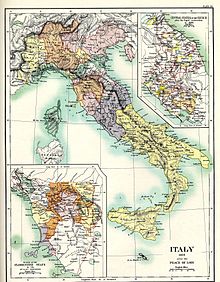
Italy after the Peace of Lodi (1454)
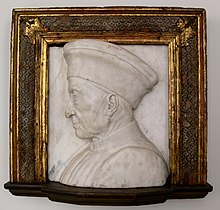
Representation of Cosimo on a high relief in marble, probably from the workshop of Antonio Rossellino, formerly attributed to Andrea del Verrocchio; Staatliche Museen, Berlin
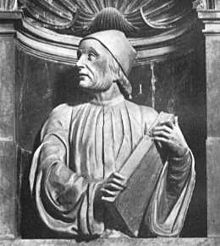
Bust of Marsilio Ficino by Andrea di Piero Ferrucci in Florence Cathedral, 1521
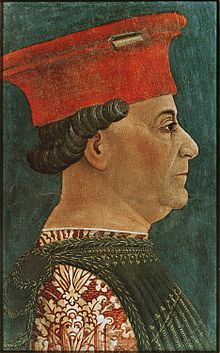
Portrait of Francesco Sforza by his court painter Bonifacio Bembo in the Pinacoteca di Brera
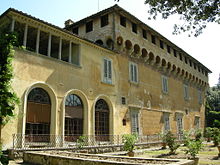
Cosimo's villa in Careggi
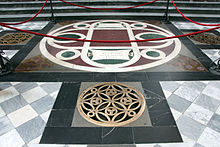
The tomb slab in San Lorenzo
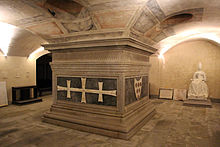
Cosimo's tomb in the crypt of San Lorenzo
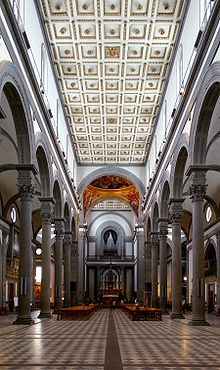
Basilica di San Lorenzo, Florence
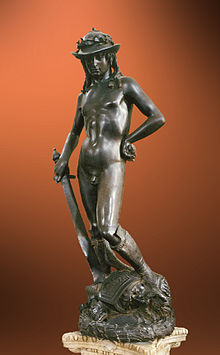
Donatello's David
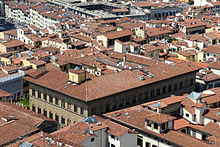
The Medici Palace seen from the Cathedral
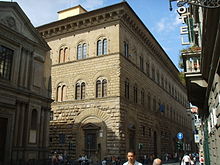
Facade and left side front of the Medici Palace
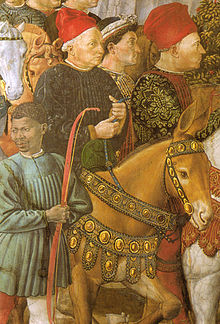
Cosimo on a fresco by Benozzo Gozzoli in the chapel of the Medici Palace, Florence
.JPG)
The Medici coat of arms on the Medici Palace
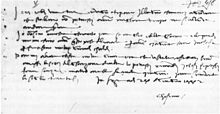
A handwritten letter from Cosimo to his son Giovanni, 24 June 1442, Florence, Archivio di Stato, Medici avanti il Principato, V, 441.
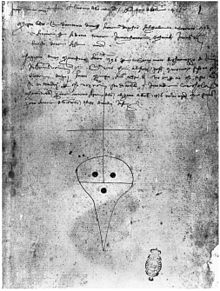
The sign used in the Medici Bank to authenticate documents. Florence, Biblioteca Nazionale Centrale, Codex Panciatichi 71, fol. 1r
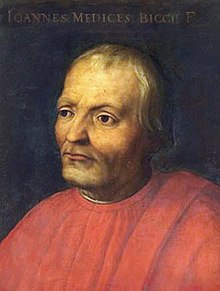
Cosimo's father Giovanni di Bicci de' Medici. Posthumous painting by Cristofano dell'Altissimo, 1562/1565. Florence, Uffizi Gallery
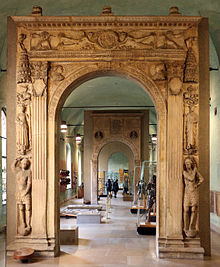
The portal of the Medici Bank in Milan. Museo d'Arte Antica, Castello Sforzesco, Milan
,_Contessina_de'_Bardi.jpg)
Cosimo's wife Contessina de' Bardi. Posthumous oil painting from the 16th century, Palazzo Pitti, Florence
Search within the encyclopedia